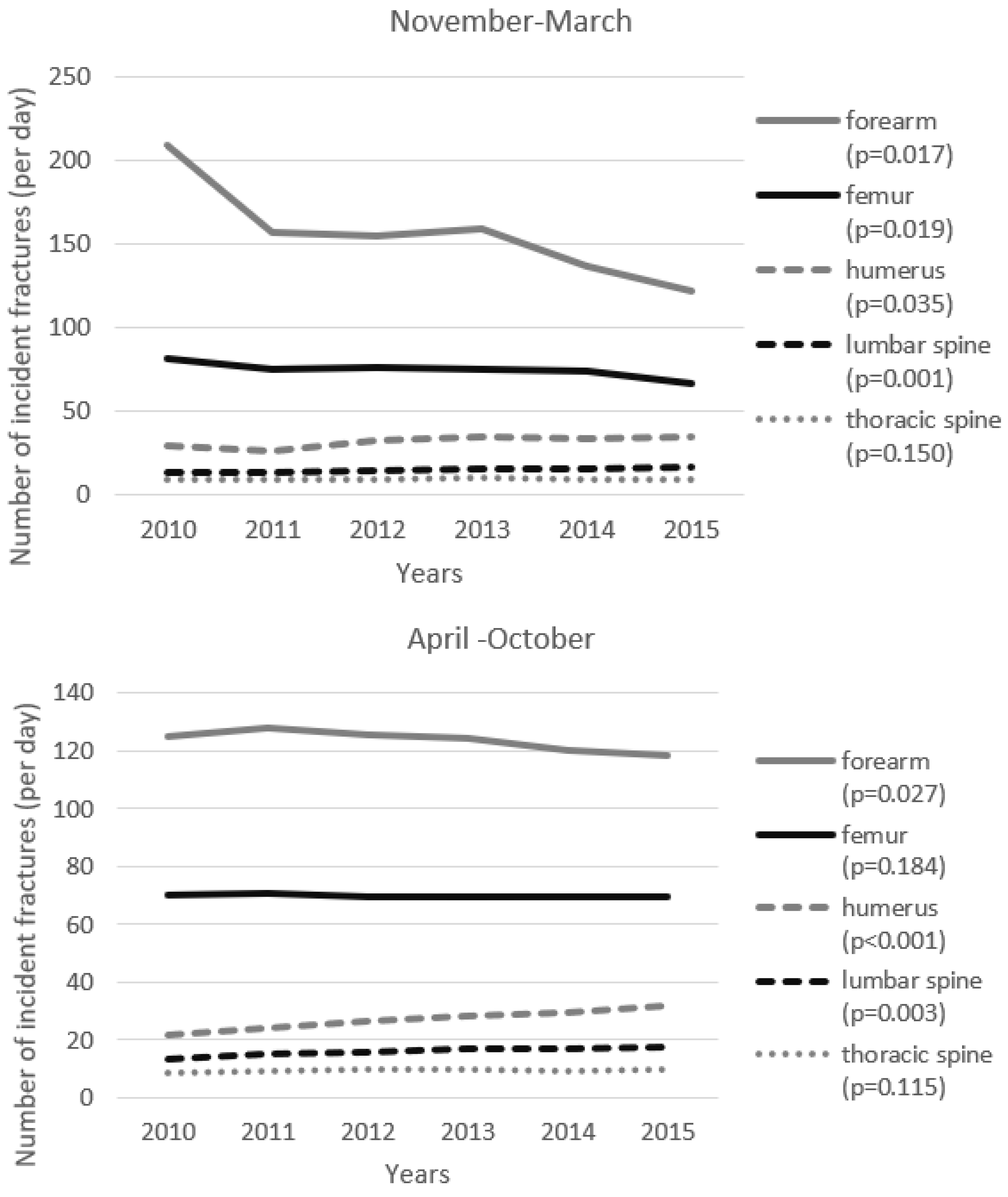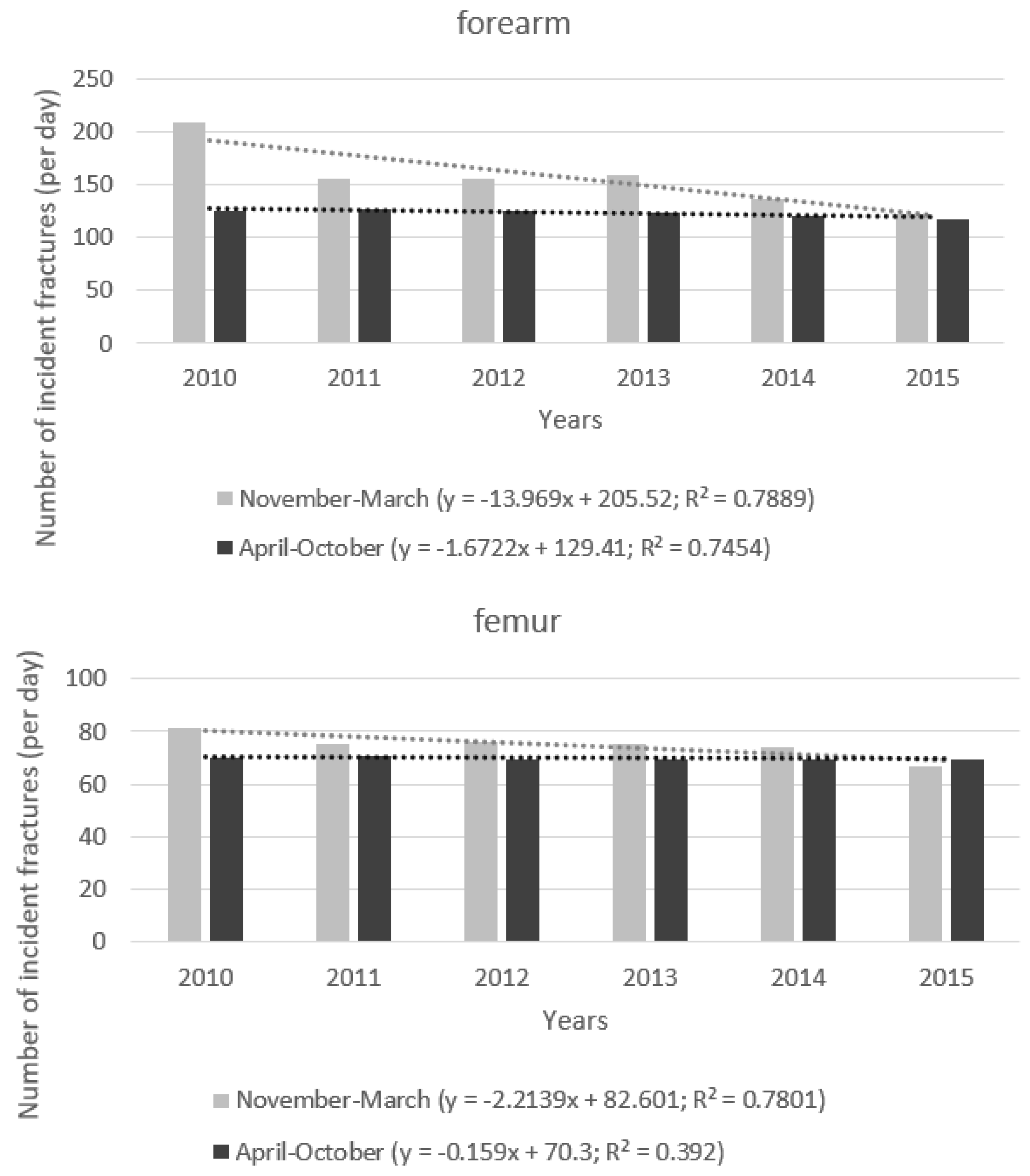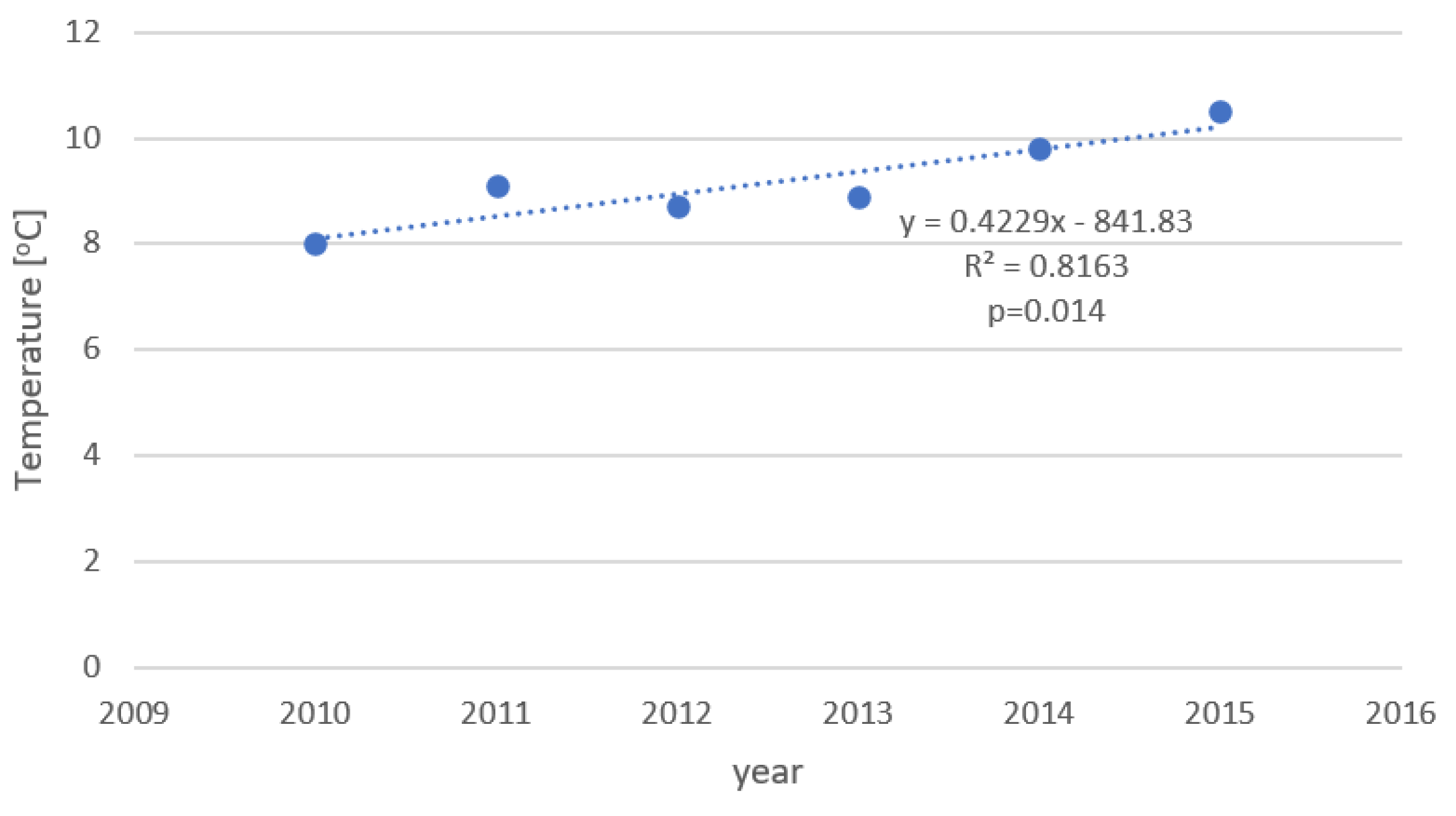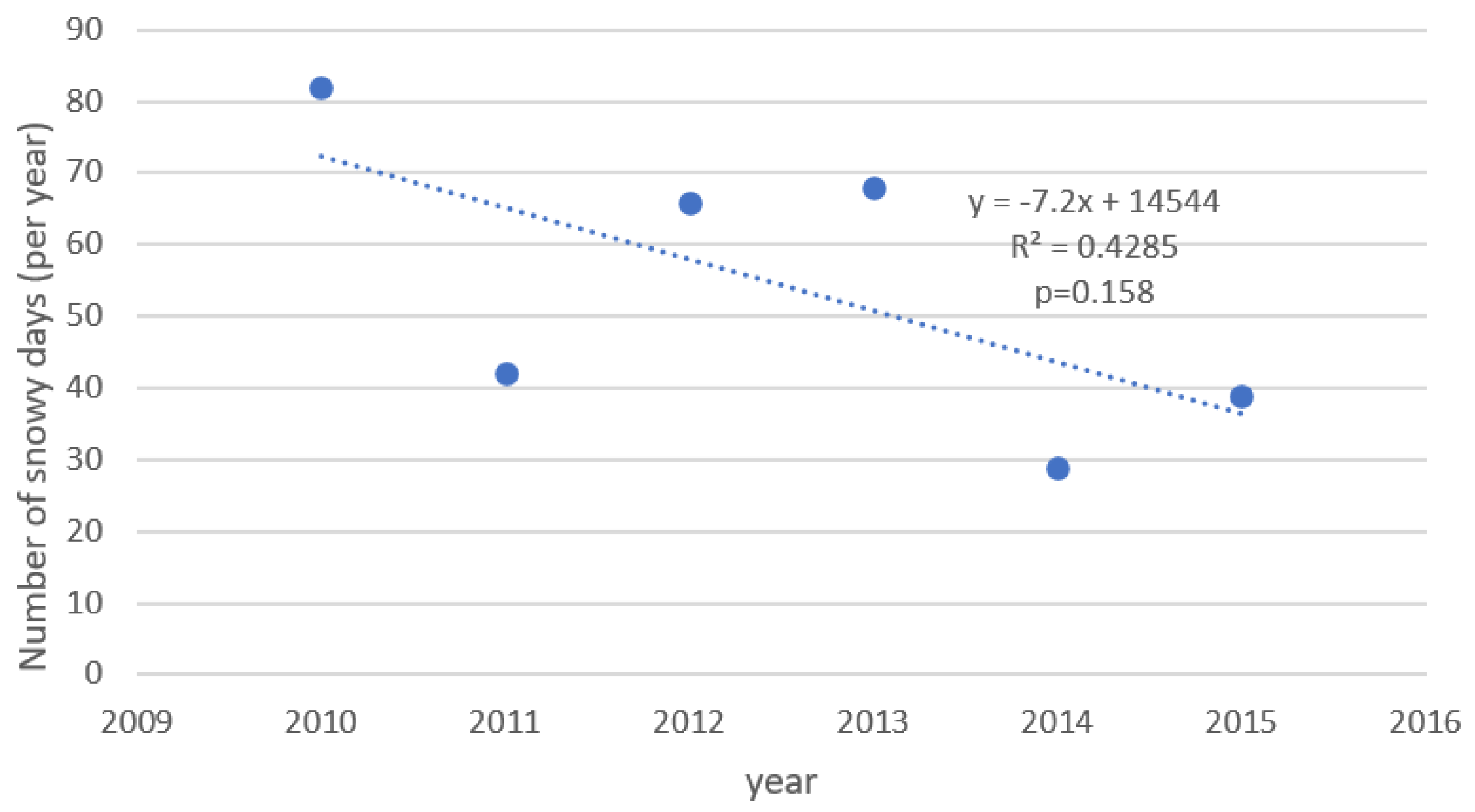Seasonally Dependent Change of the Number of Fractures after 50 Years of Age in Poland—Analysis of Combined Health Care and Climate Datasets
Abstract
:1. Introduction
2. Materials and Methods
Statistical Analysis
3. Results
4. Discussion
5. Conclusions
Author Contributions
Funding
Data Availability Statement
Conflicts of Interest
References
- Cauley, J.A. Global burden of fractures. Lancet Healthy Longev. 2021, 2, e535–e536. [Google Scholar] [CrossRef]
- Cheng, X.; Yang, Y.; Schwebel, D.C.; Liu, Z.; Cheng, P.; Ning, P.; Hu, G. Population aging and mortality during 1990–2017: A global decomposition analysis. PLoS Med. 2020, 17, e1003138. [Google Scholar] [CrossRef] [PubMed]
- Lopez, A.D.; Mathers, C.D.; Ezzati, M.; Jamison, D.T.; Murray, C.J.L. (Eds.) Global Burden of Disease and Risk Factors; World Bank: Washington, DC, USA; Oxford University Press: New York, NY, USA, 2006. [Google Scholar]
- Krug, E.G.; Sharma, G.K.; Lozano, R. The global burden of injuries. Am. J. Public Health 2000, 90, 523–526. [Google Scholar]
- Sethi, A.K.; Tyagi, A. Trauma untamed as yet. Trauma Care 2001, 11, 89–90. [Google Scholar]
- Farr, J.N.; Melton, L.J., III; Achenbach, S.J.; Atkinson, E.J.; Khosla, S.; Amin, S. Fracture Incidence and Characteristics in Young Adults Aged 18 to 49 Years: A Population-Based Study. J. Bone Miner. Res. 2017, 32, 2347–2354. [Google Scholar] [CrossRef] [PubMed]
- Buhr, A.J.; Cooke, A.M. Fracture patterns. Lancet 1959, 1, 531–536. [Google Scholar] [CrossRef]
- Peck, W.A. Consensus development conference: Diagnosis, prophylaxis and treatment of osteoporosis. Am. J. Med. 1993, 94, 646–650. [Google Scholar]
- Available online: https://www.iofbonehealth.org/references-facts-and-statistics#ref_253 (accessed on 10 March 2019).
- Seeley, D.G.; Browner, W.S.; Nevitt, M.C.; Genant, H.K.; Scott, J.C.; Cummings, S.R.; The Study of Osteoporotic Fractures Research Group. Which fractures are associated with low appendicular bone mass in elderly women? Ann. Intern. Med. 1991, 115, 837–842. [Google Scholar] [CrossRef]
- Kanis, J.A.; Borgström, F.; Compston, J.; Dreinhöfer, K.; Nolte, E.; Jonsson, L.; Lems, W.F.; McCloskey, E.V.; Rizzoli, R.; Stenmark, J. SCOPE: A scorecard for osteoporosis in Europe. Arch. Osteoporos. 2013, 8, 144. [Google Scholar] [CrossRef] [PubMed] [Green Version]
- Czerwiński, E.; Boczoń, E.; Kumorek, A. Epidemiology of osteoporotic fractures. Postępy Nauk Med. 2012, 3, 206–212. [Google Scholar]
- Peel, N.M.; Kassulke, D.J.; McClure, R.J. Population based study of hospitalised fall related injuries in older people. Inj. Prev. 2002, 8, 280–283. [Google Scholar] [CrossRef] [PubMed] [Green Version]
- Román Ortiz, C.; Tenías, J.M.; Estarlich, M.; Ballester, F. Systematic review of the association between climate and hip fractures. Int. J. Biometeorol. 2015, 59, 1511–1522. [Google Scholar] [CrossRef] [PubMed]
- Bischoff-Ferrari, H.A.; Orav, J.E.; Barrett, J.A.; Baron, J.A. Effect of seasonality and weather on fracture risk in individuals 65 years and older. Osteoporos. Int. 2007, 18, 1225–1233. [Google Scholar] [CrossRef] [PubMed] [Green Version]
- Mazzucchelli, R.; Crespí-Villarías, N.; Pérez-Fernández, E.; Reguera, M.L.D.; Illescas, O.G.; Quirós, J.; García-Vadillo, A.; Carmona, L.; Rodriguez-Caravaca, G.; Gil de Miguel, A. Weather conditions and their effect on seasonality of incident osteoporotic hip fracture. Arch. Osteoporos. 2018, 10, 2231–2241. [Google Scholar] [CrossRef] [PubMed]
- Jacobsen, S.J.; Sargent, D.J.; Atkinson, E.J.; O’Fallon, W.M.; Melton, L.J., 3rd. Population-based study of the contribution of weather to hip fracture seasonality. Am. J. Epidemiol. 1995, 141, 79–83. [Google Scholar] [CrossRef]
- Lau, E.M.; Gillespie, B.G.; Valenti, L.; O’Connell, D. The seasonality of hip fracture and its relationship with weather conditions in New South Wales. Aust. J. Public Health 1995, 19, 76–80. [Google Scholar] [CrossRef]
- Ralis, Z.A. Epidemic of fractures during period of snow and ice. Br. Med. J. (Clin. Res. Ed.) 1981, 282, 603–605. [Google Scholar] [CrossRef] [Green Version]
- Levy, A.R.; Bensimon, D.R.; Mayo, N.E.; Leighton, H.G. Inclement weather and the risk of hip fracture. Epidemiology 1998, 9, 172–177. [Google Scholar] [CrossRef] [PubMed]
- Parker, M.J.; Martin, S. Falls, hip fractures and the weather. Eur. J. Epidemiol. 1994, 10, 441–442. [Google Scholar] [CrossRef]
- Data from the Weather Station Warszawa-Okęcie. Available online: https://en.tutiempo.net/climate/poland/2/ (accessed on 20 March 2022).
- Southerland, L.T.; Barrie, M.; Falk, M.; Menaker, J. Fractures in Older Adults. Emerg. Med. Rep. 2014, 35, 1–13. [Google Scholar]
- Giladi, A.M.; Shauver, M.J.; Ho, A.; Zhong, L.; Kim, H.M.; Chung, K.C. Variation in the Incidence of Distal Radius Fractures in the US Elderly as Related to Slippery Weather Conditions. Plast. Reconstr. Surg. 2014, 133, 321–332. [Google Scholar] [CrossRef] [PubMed] [Green Version]
- Pereira, C.L.N.; Vogelaere, P.; Baptista, F. Role of physical activity in the prevention of falls and their consequences in the elderly. Eur. Rev. Aging Phys. Act. 2008, 5, 51–58. [Google Scholar] [CrossRef] [Green Version]
- Available online: http://www.mpz.mz.gov.pl/ (accessed on 10 March 2022).
- Czach, K.; Klonowska, K.; Świderek, M.; Wiktorza, K. Poland: The “Jednorodne Grupy Pacjentów”—Polish experiences with DRGs. In Diagnosis-Related Groups in Europe: Moving towards Transparency, Efficiency and Quality in Hospitals; Busse, R., Geissler, A., Quentin, W., Wiley, M., Eds.; Open University Press: Maidenhead, UK, 2011; pp. 259–379. [Google Scholar]
- Bergström, U.; Björnstig, U.; Stenlund, H.; Jonsson, H.; Svensson, O. Fracture mechanisms and fracture patterns in men and women aged 50 years and older: A study of a 12-year population-based injury register, Umea, Sweden. Osteoporos. Int. 2008, 19, 1267–1273. [Google Scholar] [CrossRef] [PubMed]
- Available online: https://data.noaa.gov/datasetsearch/ (accessed on 22 March 2022).
- Liu, B.; Kim, H.-J.; Feuer, E.J.; Graubard, E.I. Joinpoint regression methods of aggregate outcomes for complex survey data. J. Surv. Stat. Methodol. 2022. [Google Scholar] [CrossRef]
- Hayashi, S.; Noda, T.; Kubo, S.; Myojin, T.; Nishioka, Y.; Higashino, T.; Imamura, T. Variation in fracture risk by season and weather: A comprehensive analysis across age and fracture site using a National Database of Health Insurance Claims in Japan. Bone 2019, 120, 512–518. [Google Scholar] [CrossRef] [PubMed]
- Zhang, F.; Zhang, X.; Zhou, G.; Zhao, G.; Zhu, S.; Zhang, X.; Xiang, N.; Zhu, W. Is Cold Apparent Temperature Associated With the Hospitalizations for Osteoporotic Fractures in the Central Areas of Wuhan? A Time-Series Study. Front. Public Health 2022, 10, 835286. [Google Scholar] [CrossRef] [PubMed]
- Ogliari, G.; Ong, T.; Marshall, L.; Sahota, O. Seasonality of adult fragility fractures and association with weather: 12-year experience of a UK Fracture Liaison Service. Bone 2021, 147, 115916. [Google Scholar] [CrossRef]
- Sheira, D.; Tennakoon, L.; Forrester, J.D. Effect of Seasonality on Variation Among Patients Presenting With Rib Fractures in the United States. Am. Surg. 2022. [Google Scholar] [CrossRef] [PubMed]
- Souza, M.M.; Souza, E.M.; Nunes, A.A.; Martinez, E.Z. Seasonal variation of femoral fractures in the state of São Paulo, Southeast Brazil. Rev. Saude Publica 2019, 53, 55. [Google Scholar] [CrossRef] [PubMed] [Green Version]
- Gao, C.; Abeysekera, J. A systems perspective of slip and fall accidents on icy and snowy surfaces. Ergonomics 2004, 47, 573–598. [Google Scholar] [CrossRef]
- Czerwiński, E.; Białoszewski, D.; Borowy, P.; Kumorek, A.; Białoszewski, A. Epidemiology, clinical significance, costs and fall prevention in elderly people. Ortop. Traumatol. Rehabil. 2008, 10, 419–428. [Google Scholar] [PubMed]
- Bell, A.; Talbot-Stern, J.; Hennessy, A. Characteristics and outcomes of older patients presenting to the emergency department after a fall: A retrospective analysis. Med. J. Aust. 2000, 173, 179–182. [Google Scholar] [CrossRef] [PubMed]
- Kannus, P.; Palvanem, M.; Niemi, S.; Parkkari, J.; Jarvinem, M. Epidemiology of osteoporotic pelvic fractures in elderly people in Finland: Sharp increase in 1970–1997 and alarming projections for the new millennium. Osteoporos. Int. 2000, 11, 443–448. [Google Scholar] [CrossRef] [PubMed]
- Kannus, P.; Palvanem, M.; Niemi, S.; Parkkari, J.; Jarvinem, M. Increasing number and incidence of low-trauma ankle factures in elderly people: Finnish statistics during 1970–2000 and projections for the future. Bone 2002, 31, 430–433. [Google Scholar] [CrossRef]
- Melton, L.; Riggs, B. Risk factors for injury after a fall. Clin. Geriatr. Med. 1985, 1, 525–539. [Google Scholar] [CrossRef]
- Palvanem, M.; Kannus, P.; Parkkari, J.; Pitkajarvi, T.; Pasanen, M.; Vuori, I.; Jarvinem, M. The injury mechanisms of osteoporotic upper extremity fractures among older adults: A controlled study of 287 consecutive patients and their 108 controls. Osteoporos. Int. 2000, 1, 822–831. [Google Scholar] [CrossRef] [PubMed]
- Pickett, W.; Hartling, L.; Brison, R.J. A population-based study of hospitalised injuries in Kingston, Ontario, identified via the Canadian Hospitals Injury Reporting and Prevention Program. Chronic Dis. Can. 1997, 18, 61–69. [Google Scholar]
- Takayuki, T. Epidemiology of fragility fractures and fall prevention in the elderly: A systematic review of the literature. Curr. Orthop. Pract. 2017, 28, 580. [Google Scholar]
- Cummings, S.R.; Nevitt, M.C.; Study of Osteoporotic Fractures Research Group. Non-skeletal determinants of fractures: The potential importance of the mechanics of falls. Osteoporos. Int. 1994, 4 (Suppl. 1), S67–S70. [Google Scholar] [CrossRef]





| Segment | Lower Endpoint | Upper Endpoint | APC | Lower CI | Upper CI | Test Statistic (t) | p | |
|---|---|---|---|---|---|---|---|---|
| Humerus | 1 | 2010 | 2015 | 6.0 | 3.6 | 8.5 | 7.0 | 0.002 |
| Femur | 1 | 2010 | 2015 | −1.4 | −2.2 | −0.6 | −5.1 | 0.007 |
| Lumbar spine | 1 | 2010 | 2015 | 5.5 | 4.1 | 6.9 | 10.9 | <0.001 |
| Thoracic spine | 1 | 2010 | 2015 | 1.7 | −0.2 | 3.6 | 2.5 | 0.07 |
| Forearm | 1 | 2010 | 2015 | −4.7 | −7.1 | −2.3 | −5.4 | 0.006 |
| Humerus | Femur | Lumbar Spine | Thoracic Spine | Forearm | |
|---|---|---|---|---|---|
| Women | |||||
| 2010 | 7198 | 19,415 | 2849 | 1751 | 57,011 |
| 2011 | 7401 | 18,650 | 3100 | 1819 | 49,487 |
| 2012 | 8429 | 18,621 | 3282 | 1981 | 49,494 |
| 2013 | 8981 | 18,574 | 3624 | 2026 | 50,030 |
| 2014 | 9087 | 18,349 | 3747 | 2013 | 45,478 |
| 2015 | 9640 | 17,578 | 3848 | 2063 | 42,387 |
| 2010–2015 | 50,736 | 111,187 | 20,450 | 11,653 | 293,887 |
| Men | |||||
| 2010 | 2911 | 7876 | 1941 | 1472 | 14,896 |
| 2011 | 2934 | 7851 | 2122 | 1520 | 13,739 |
| 2012 | 3400 | 7749 | 2266 | 1548 | 13,546 |
| 2013 | 3546 | 7669 | 2254 | 1554 | 13,099 |
| 2014 | 3500 | 7687 | 2295 | 1467 | 12,190 |
| 2015 | 3701 | 7424 | 2450 | 1460 | 11,782 |
| 2010–2015 | 19,992 | 46,256 | 13,328 | 9021 | 79,252 |
| Total population | |||||
| 2010–2015 | 70,728 | 157,443 | 33,778 | 20,674 | 373,139 |
| Humerus | Femur | Lumbar Spine | Thoracic Spine | Forearm | |
|---|---|---|---|---|---|
| Relative risk | 1.170 | 1.073 | 0.910 | 0.965 | 1.267 |
| 95% CI | 1.111–1.231 | 1.039–1.109 | 0.847–0.976 | 0.881–1.056 | 1.238–1.297 |
| p | <0.001 | <0.001 | 0.009 | 0.433 | <0.001 |
| Humerus | Femur | Lumbar Spine | Thoracic Spine | Forearm | |
|---|---|---|---|---|---|
| Mean temperaturę in January | 36.42 + 0.55 × (0.518) | 78.97 − 0.92 × (0.222) | 15.04 + 0.15 × (0.679) | 10.07 + 0.10 × (0.212) | 184.82 − 5.73 × (0.329) |
| Mean temperature in February | 32.91 + 0.60 × (0.539) | 74.58 − 0.83 × (0.112) | 15.17 + 0.55 × (0.023) | 9.61 + 0.17 × (0.330) | 174.55 − 4.28 × (0.467) |
| Mean temperature in March | 31.18−0.68 × (0.350) | 73.70 − 0.87 × (0.177) | 13.63 + 0.15 × (0.619) | 8.78 + 0.01 × (0.902) | 164.70 − 9.19 × (0.030) |
| Mean temperature in November | 24.40 + 0.50 × (0.736) | 64.95 + 0.68 × (0.310) | 15.17 − 0.10 × (0.881) | 8.08 + 0.20 × (0.453) | 95.31 + 1.94 × (0.704) |
| Mean temperature in December | 36.00 − 0.56 × (0.170) | 79.50 − 3.25 × (0.032) | 14.94 + 0.26 × (0.137) | 9.20 − 0.07 × (0.453) | 174.72 − 16.48 × (0.002) |
| Mean temperature for the cold season (November–March) | 30.62 + 1.05 × (0.268) | 77.40 − 2.52 × (0.005) | 13.86 + 0.71 × (0.044) | 9.18 + 0.07 × (0.556) | 172.00 − 15.22 × (0.014) |
| Number of snowy days (per year) | 33.26 − 0.03 × (0.739) | 66.21 + 0.16 × (0.123) | 16.72 − 0.04 × (0.264) | 9.38 + 0.00 × (0.805) | 92.66 + 1.18 × (0.044) |
| Mean annual temperature | 0.65 + 3.09 × (0.070) | 91.85 − 2.18 × (0.005) | 1.52 + 1.52 × (0.023) | 7.29 + 0.23 × (0.258) | 273.54 − 14.87 × (0.003) |
Publisher’s Note: MDPI stays neutral with regard to jurisdictional claims in published maps and institutional affiliations. |
© 2022 by the authors. Licensee MDPI, Basel, Switzerland. This article is an open access article distributed under the terms and conditions of the Creative Commons Attribution (CC BY) license (https://creativecommons.org/licenses/by/4.0/).
Share and Cite
Jedynasty, K.; Zięba, M.; Adamski, J.; Czech, M.; Głuszko, P.; Gozdowski, D.; Szypowska, A.; Śliwczyński, A.; Walicka, M.; Franek, E. Seasonally Dependent Change of the Number of Fractures after 50 Years of Age in Poland—Analysis of Combined Health Care and Climate Datasets. Int. J. Environ. Res. Public Health 2022, 19, 9467. https://doi.org/10.3390/ijerph19159467
Jedynasty K, Zięba M, Adamski J, Czech M, Głuszko P, Gozdowski D, Szypowska A, Śliwczyński A, Walicka M, Franek E. Seasonally Dependent Change of the Number of Fractures after 50 Years of Age in Poland—Analysis of Combined Health Care and Climate Datasets. International Journal of Environmental Research and Public Health. 2022; 19(15):9467. https://doi.org/10.3390/ijerph19159467
Chicago/Turabian StyleJedynasty, Kinga, Mariusz Zięba, Jakub Adamski, Marcin Czech, Piotr Głuszko, Dariusz Gozdowski, Agnieszka Szypowska, Andrzej Śliwczyński, Magdalena Walicka, and Edward Franek. 2022. "Seasonally Dependent Change of the Number of Fractures after 50 Years of Age in Poland—Analysis of Combined Health Care and Climate Datasets" International Journal of Environmental Research and Public Health 19, no. 15: 9467. https://doi.org/10.3390/ijerph19159467
APA StyleJedynasty, K., Zięba, M., Adamski, J., Czech, M., Głuszko, P., Gozdowski, D., Szypowska, A., Śliwczyński, A., Walicka, M., & Franek, E. (2022). Seasonally Dependent Change of the Number of Fractures after 50 Years of Age in Poland—Analysis of Combined Health Care and Climate Datasets. International Journal of Environmental Research and Public Health, 19(15), 9467. https://doi.org/10.3390/ijerph19159467







